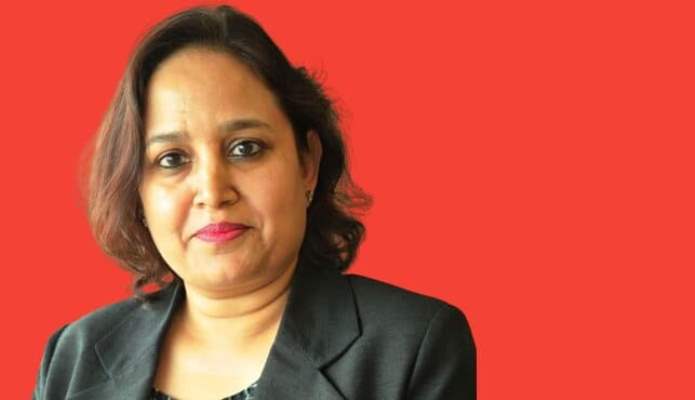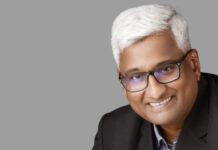In an exclusive interaction with SightsIn, we have with us Madhavi Lall- Managing Director and Head Human Resources, India at Deutsche bank, She has been heading HR at Deutsche Bank India since May 2015 and joined from Accenture where she was Managing Director – HR. She has earlier held several senior leadership positions in Standard Chartered Bank where her last role was Global Head – Employee Relations. Prior to this, she was the Regional Head of HR India & South Asia and a Director on the Board of Standard Charted Finance Limited since Jan 2007. Madhavi has also worked with other companies like ABN Amro bank, Colgate Palmolive and HCL Hewlett- Packard.
She completed her MBA in HR and systems from XLRI Jamshedpur in 1991 and has pursued a Master’s degree in Mathematics from St. Stephen’s College. She has also completed a Leadership management course from the University of Oxford.
Madhavi was conferred the “Women Leadership Award” by the jury and Council of Board Members of the Institute of Public Enterprises-BFSI in 2010. She was awarded the ‘GNOSIS Excellence Award’ in 2016 by the Finance Association at XLRI for recognition of her contribution to the BFSI sector and the XLRI brand over the years. She is also a founding member of the HR Committee for FICCI. Most recently she was conferred the Distinguished Alumnus Award by XLRI.
Q-Managing the Talent and aligning them to common goal is a big challenge but key to success for any organization, How do you manage that?
Open, transparent and robust communication channels across the organization make this possible. A variety of interventions from all levels in the organization – right from town halls by our CEO and the Management Board to regular department meetings, help employees to ask questions and seek clarifications.
Over communicating should never seem like a challenge – different staff have different ways through which they understand and internalize the common goals of the organization and a good mix of communication channels is very important in reaching out to employees. Senior management should understand and respect the needs of employees thus enabling use of multiple channels of communication.
The other key to success in this is helping each employee understand how their role contributes to the success of the larger organization. Our purpose as a business is to enable economic growth and societal progress. We want to be a bank that realizes plans and ambitions for clients, employees, investors and communities.
We have an ongoing conversation about this among employees, because whether one works with clients or in a support role, each one of makes a positive impact and play a part in helping move the bank forward. This is just one example of how aligning talent to a common goal need not necessarily be top down. It can be built through creating a common sense of pride in our purpose as an organization.
Q-How do you see talent management strategy is evolving especially in Banking Industry and what challenges you are facing in meeting your talent strategy goals?
Our industry is going through a transformation, driven by competition, regulation and advancements in technology. Some of the key challenges include, identifying sources of future growth, constantly delivering regulatory driven change at a low cost, reducing structural costs and rebuilding trust. These challenges exist against the backdrop of a few global megatrends – the global rise of the entrepreneur, faster growth and favorable demographics in emerging markets and the digital revolution.
Our industry is going through a transformation, driven by competition, regulation and advancements in technology. Some of the key challenges include, identifying sources of future growth, constantly delivering regulatory driven change at a low cost, reducing structural costs and rebuilding trust.
The key focus of talent management now is identifying the strengths and skills required for the present and the future and then hiring and developing these through innovative work arrangements as the open talent economy becomes ubiquitous and mainstream.
One of the challenges is predicting skills that will be required in the future. The main reason for that is the accelerated speed of development of technology. Imagine the future of work – what do you see? Do you see offices teeming with AI? Do you predict that changing demographics will rewrite the rules of who works, and how long? Or do you anticipate the rise of a global gig economy where most people are working for themselves?
All of these scenarios are emerging – but looking at them in isolation misses the point. We need to zoom out and see the big picture.
In such a dynamic world, keeping ahead of the developments in the external world and the rapidly changing competitive scenario is another challenge. Organizations will need to continuously recalibrate technology, workplaces and talent to remain relevant
Q-How do you access the best talent and leverage your employer brand to do so?
Our EVP is brought to life through consistent messaging that is used both internally and externally. Whether we are hiring graduates or professionals the messages are tailored to ensure that they resonate with our target audiences and are constantly refined through extensive global consultation and local insights. This helps us to communicate in a way that is attractive to our audiences and, more importantly, is an accurate reflection of who we are as an organization. We also actively engage with our audience through various social media channels such as Facebook, Twitter, YouTube and LinkedIn.
Q-What is experience –driven talent management to you and how does it help attract and retain talent in organizations?
The 70-20-10 rule that many companies now follow is central to our talent development philosophy too. On-the job training, mentoring and peer forums form a big part of our talent development agenda. We encourage internal mobility across functions and geographies. This helps us leverage the vast experience and skills across the organization while providing employees with continuous avenues for interest-aligned growth. This has also contributed to our brand proposition and helped us retain talent. Our regular classroom offerings are aided by a best-in-class digital curriculum that helps employees create customized learning paths based on their individual needs.
Q-How do you see Technology trends in Talent Management?
Technology has enabled talent management like never before. When I started my career, lists would be written down or typed out and recorded in file. After a couple of years, the data moved to an excel equivalent, (which I think was Lotus 123) and now technology is quite central to hiring and managing talent.
Technology is enabling recruiters to better identify and target talent. Intelligent sourcing analytics, video interview analysis, chatbots for candidates, and culture fit assessment through natural language processing, bias detection-cognitive technology is changing recruiting everywhere.
Employers are giving up the annual survey and replacing it with real-time ongoing feedback and engagement apps.
The definition of talent is itself expanding to shift focus from permanent full-time employees to flexible work arrangements.
An increasing number of organizations are shifting to a cloud based systems for streamlined processes and seamless employee experience.
Total Performance (TP) is how we manage performance and career development at Deutsche Bank. It’s an integrated approach, based on regular, meaningful two-way conversations. All conversations are documented in a single system. The system empowers managers and the HR team to view reports with real-time talent insights instead of a single rating view to performance and development.
Q-What are your key suggestions for improving talent management process?
In my experience, if the talent management process has to be successful, it needs to align to the business requirements as well as to an employee’s aspirations. The process should also have clear and measurable outcomes.
In practice this can sometimes be difficult to do though, but if we miss doing this, our efforts may not yield the desired results.
I also believe that talent management processes with a mass outlook will no longer work. In a constantly changing world, talent will be a key differentiator. Organizations need to be able to deliver on individualized customization of development and growth outcomes for identified target population.
Developing robust employee listening mechanisms will be necessary to constantly revisit brand perception and proactively act on employee pulse.
Employers should be able to create heat maps with an organization wide skill outlook to reimagine possible career paths for employees through identification of primary and secondary skills.
Q-Some recent researches prove that women are slightly ahead of men in learning tech skills, while women in Tech is big agenda of discussion today, why is it that women are still in lesser numbers when it comes to Technology?
In my personal opinion, the reason we have fewer women in technology is because right from early childhood women are made to believe that they would be better at arts and not the sciences. We all have a role to play here – in our families, extended families, friends’ circles and society at large, to make sure this does not remain an issue and things change in the next few decades.
We should also create workplaces which enable women to excel in these careers. In careers where women are few, it is important that women have access to female role models and mentors who can help them navigate and excel.
Q-Automation is noted as threat for employment in Banking Industry, how do you see job opportunities in coming days?
As technology becomes more sophisticated, the threat that this automation will displace some traditional jobs is very real. We are also discussing how the role of HR will change with the advent of so many apps and robots!
However, evidence shows that if technology really destroyed jobs, there would have been no work today for anyone. The technological revolution we have seen in the past 30 years has been unparalleled and exponential, and yet there are more jobs and probably better salaries.
Therefore your question is very relevant as the conversation needs to be about the jobs that can and will be created in the future.
As an example, the banking industry has undergone changes over the years where some of the traditional tasks like updating passbooks, cash deposits, verification of KYC details, salary uploads have been automated for operational efficiency and employees can now focus on roles such as advisory and consultation, which are add more value to clients.
When the first automation happened in banking more than two decades ago, there was a fear that people will be asked to leave. The way this transformation was handled was that people were trained to learn new skills. I have no reason to believe that the same will not happen now as well.
Note- Views are personal & not of the organization.
Thank you Madhavi!









